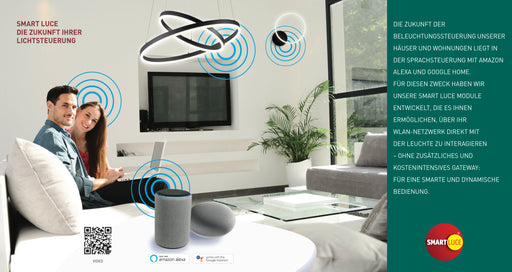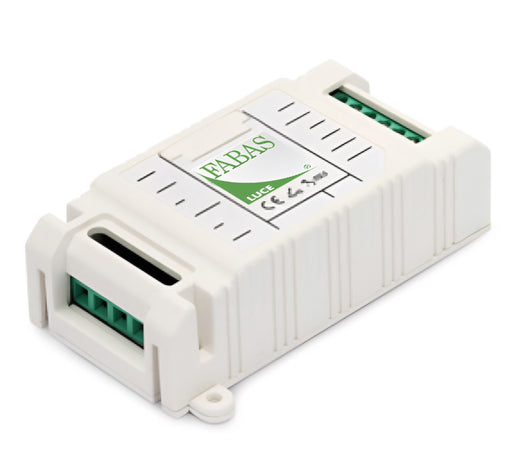Dimmer, light control
-

 Save 0%
Save %
Original price 89,95 € - Original price 89,95 €Original price89,95 €89,95 € - 89,95 €Current price 89,95 €| /
Save 0%
Save %
Original price 89,95 € - Original price 89,95 €Original price89,95 €89,95 € - 89,95 €Current price 89,95 €| /Smartluce Dimmer für Ein/Aus Funktion + Dimmung über Sprachfunktion oder App, Kunststoff/Metall, weiß
Fabas LuceBeschreibung Optionales Zubehör für Smarthome- und Sprachsteuerungs-Kompatibilität mit Amazon Alexa und Google Home, DIMM-Modul. Das gängigste Mod...
View full detailsLieferzeit: 5-12 Werktage
Dimmers are electronic devices that are typically used to adjust the brightness of lamps and lights. They allow the user to dim the light in a room according to their needs, which has many advantages. In this technical article we go into detail about dimmers and explain how they work, what types of dimmers there are and what advantages they offer.
How do dimmers work?
Dimmers regulate the brightness of lamps and lights by reducing the current flowing through the lamp. When the dimmer is set to its lowest level, only a fraction of the current flows through the lamp and the light is dimmed accordingly. If the dimmer is set to the highest level, current flows through the lamp and the light becomes correspondingly brighter.
There are different types of dimmers, but they all work in the same way. The dimming module is programmed between the power source (e.g. socket) and the lamp and regulates the current flow through the lamp. With conventional dimmers, this is done by so-called leading edge or trailing edge, i. H. the voltage waves of the ballast are cut off at the beginning or end in order to reduce the current and thus the brightness of the lamp.
Types of dimmers
There are different types of dimmers, including conventional leading edge dimmers, trailing edge dimmers, but also more modern variants such as PWM dimmers, DALI dimmers and Casambi dimmers.
Leading Edge and Trailing Edge Dimmers (also called Leading Edge or Trailing Edge Dimmers): These are the most commonly used types of dimmers. Leading edge dimmers work by clipping the beginning of the AC waveform, while trailing edge dimmers clip the slope. Trailing edge dimmers work best with LEDs, while trailing edge dimmers are commonly used with incandescent or halogen lamps.
PWM Dimmer: These dimmers regulate the brightness by switching them on and off quickly. The time the light is on will change to change the brightness. PWM dimmers are very efficient and are often used for LEDs.
DALI Dimmer: DALI stands for Digital Addressable Lighting Interface. With these dimmers, users can control multiple lamps individually and create different lighting scenarios. They are often found in commercial buildings where complex lighting systems are required.
Casambi dimmer: These dimmers are wireless and controlled via Bluetooth. They offer an easy way to dim the lights and create different scenes without the need for complicated wiring.
Advantages of dimmers
By being able to adjust the light intensity in the room, dimmers offer many advantages, both in terms of comfort and energy efficiency.
-
Comfort: An important advantage of dimmers is the additional comfort they offer. With the dimmer you can adjust the brightness of the light to your needs and thus create a cozy atmosphere. Dimmers also allow you to dim the light to create a relaxing atmosphere in the room. For example, if you want to watch a movie or read a book, you can dim the light to a comfortable level to create a relaxing atmosphere.
-
Energy efficiency: The dimmers can also contribute to significant energy savings. When you dim the light, less electricity is required to produce light. This leads to a reduction in energy consumption and thus also in electricity bills. By using a dimmer, energy consumption can be reduced by up to 80%. This is particularly important at a time when energy efficiency and sustainability are becoming increasingly important.
-
Increased service life of the lamp/luminaire:The use of dimmers can also extend the service life of the lamp. When lamps are operated at full brightness, more current flows through them, causing more wear and reducing lamp life. Using a dimmer reduces the current and therefore the wear and tear on the lamp, resulting in a longer lamp life. As a result, the lamps need to be replaced less often, which not only saves time and effort, but also reduces the environmental impact.
- Mood brightener:Different atmospheres can also be created in the room with dimmers. By playing with the brightness of the light, you can create a variety of moods, from romantic lighting to a bright work environment. This is particularly useful in places like restaurants where a warm atmosphere needs to be created, or in offices where a different environment is needed for different tasks.
Conclusion
Dimmers are a simple but effective way of controlling the brightness of lamps and lights. They provide additional comfort, reduce energy consumption and extend the life of the luminaire. In addition, they can create different moods in a room, making them an extremely versatile lighting tool. The use of dimmers is therefore a wise investment for anyone who wants to control lighting conveniently and energy-efficiently.


